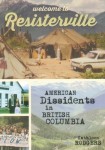It is an immigrants’ story like no other.
British Columbia’s Kootenay region was for years a quiet, peaceful land of alpine valleys and crystal streams, peopled by Catholic loggers and miners, New Democrats and Social Creditors – “blue collar”, one MP called it.
Suddenly, the Vietnam War happened.
University of Ottawa sociologist Kathleen Rodgers in her compelling narrative tells what came next: from 1965 thousands of U.S. draft evaders crossed the border to settle in the Kootenays, cursing U.S. militarism and actually building communes with names like New Family and Harmony’s Gate. “Some focused on ‘free love’,” Rodgers notes.
There had never been anything quite like it. True, Canada has been a haven for American draft dodgers since the U.S. Civil War, and northern migrations are nothing new: it was the century-old influx of Montana cowpunchers and Utah Mormons that even today gives southern Alberta its unbending conservatism.
These immigrants were different: educated, left-wing commune-ists armed with Jimi Hendrix posters and the mail-order Whole Earth Catalog. “The young Americans who crossed the Canadian border between 1965 and 1975 were not necessarily radical leaders of student politics or even committed activists, but they had come of age during a period of transformative political and cultural change,” Rodgers writes.
Resisterville chronicles the transformation. The title of the book draws from a 2004 New York Times article on protests that erupted in Nelson, B.C. when advocates attempted to erect a public monument honouring draft evaders. “The whole statue issue was just a shame,” one tells Rodgers; “When draft dodgers came to this country people were so willing to have us.”
Resisterville documents an astonishing fact: of the 100,000 Americans of draft age who emigrated to Canada in the era of the Vietnam War, half stayed. Of those 40 percent settled in B.C. In the West Kootenays today Americans comprise 25 percent of the immigrant population.
The result was a California-style “counterculture”, Rodgers writes. Americans inspired a short-lived newspaper The Arrow; a feminist theatre group that produced the works of Ibsen; a natural food co-op; “free schools” that taught candle-making; and a lifestyle that irritated officialdom.
In 1972 one local MLA complained in the B.C. legislature that the valleys were under siege by “an invasion of American hippies” who liked to skinny dip in the lakes. Local media lamented that “hippies had completely taken over the Steven’s Creek campsite”; MP Herbert Herridge, a New Democrat, disparaged the newcomers as “ragheads”, an epithet of uncertain origin.
“In the decades following their arrival in the West Kootenays the newcomers’ pacifist principles remained a core component of the countercultural identity in the community,” writes Rodgers. “Their activities included lobbying for the region to become a nuclear-free zone; marching in anti-war protests; traveling to peace rallies at the site of the Hanford nuclear reactor in Washington in the 1980s; organizing festivals in celebration of peace; protesting against the war in Iraq.”
Rodgers’ research is meticulous, including vivid interviews with scores of “hippies” who made the Kootenays home. “It was hard,” one remarked; “Somebody who had a PhD in biology got a job driving the coal truck at the co-op.”
“People found it wasn’t as easy to live the dream of peace and love as they thought.”
By Tom Korski
Welcome To Resisterville: American Dissidents In British Columbia by Kathleen Rodgers; University of British Columbia Press; 219 pages; ISBN 9780-7748-27348; $29.95






